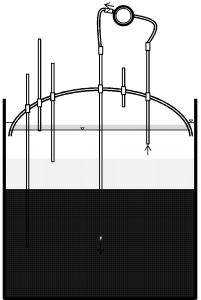An Anaerobic Sequencing Batch Reactor (ASBR) is a high-rate liquid digestion system that retains microflora in the reactor by sequentially feeding influent, mixing the reactor, settling solids, and decanting effluent from the top of the reactor (Figure 1). All operations take place in a single reactor vessel. Since solids are retained in the reactor vessel, Solids Retention Time (SRT) can be managed separately from Hydraulic Retention Time (HRT). Although ASBR digesters are highly efficient at conversion of low-solids high-energy organic liquids to biogas, very few designs have made it out of the laboratory and onto the farm. Two problems have hindered ASBR development: detachment of roofs from reactor vessels and poor settling and retention of solids.

What did we do?
Improvements to ASBR design at Oklahoma State University have led to a patent pending invention that solves both settling roof detachment problems (Figure 2). Roof detachment is alleviated by employing a floating cover. The new design uses a partial mixing system — suspended solids are lifted below the mixing withdrawal point during the react phase of the ASBR cycle. The decanting point is fixed relative to the floating cover, so effluent is decanted from the clear liquid above the cloud of settling solids.

What did we learn?
A battery of six, 30L reactors were operated under full and then partial mixing schemes with an HRT of 15 days and an Organic Loading Rate (OLR) of 0.31 g COD L-1 day-1. Partial mixing greatly improved reactor performance as measured in effluent quality and solids retention. Effluent from the reactors operated under the partial mixing scheme had significantly (p = 0.05) lower Total Suspended Solids (TSS) compared to the fully mixed reactors – 129 versus 452 mg L-1. Average SRT of the partially mixed reactors was 760 days versus 72 days for the fully mixed reactors. Biogas production was largely unaffected by switching from fully mixed to partially mixed operation. Average volumetric reactor efficiency (VRE) was 0.23 L biogas L1 reactor day-1 under full mixing and 0.28 L biogas L1 reactor day-1 under partial mixing.
When OLR was increased on the partially mixed reactors to 0.62 g COD L-1 day-1 with an HRT of 7.5 days, TSS concentration of effluent remained below 200 mg L-1 with an average of 183 mg L-1. Average SRT was 440 days, and VRE rose to 0.70 L biogas L1 .reactor day-1. Organic matter removal efficiency measured as Chemical Oxygen Demand (COD) averaged 0.91%.
Future Plans
Prototype testing of reactor at HRT < 5 days and OLR > 1.0 g g COD L-1day-1 is currently underway. After that we plan to construct a 1,000 L mobile reactor for on-farm testing.
Author
Douglas W. Hamilton
Associate Professor and Extension Waste Management Specialist
Biosystems and Agricultural Engineering
Oklahoma State University
The authors are solely responsible for the content of these proceedings. The technical information does not necessarily reflect the official position of the sponsoring agencies or institutions represented by planning committee members, and inclusion and distribution herein does not constitute an endorsement of views expressed by the same. Printed materials included herein are not refereed publications. Citations should appear as follows. EXAMPLE: Authors. 2019. Title of presentation. Waste to Worth. Minneapolis, MN. April 22-26, 2019. URL of this page. Accessed on: today’s date.

